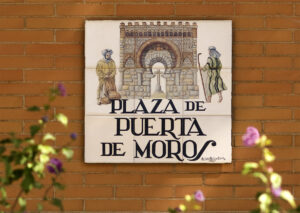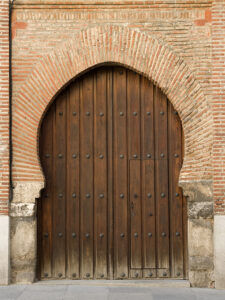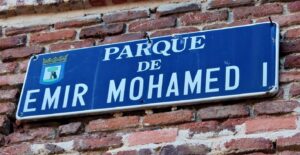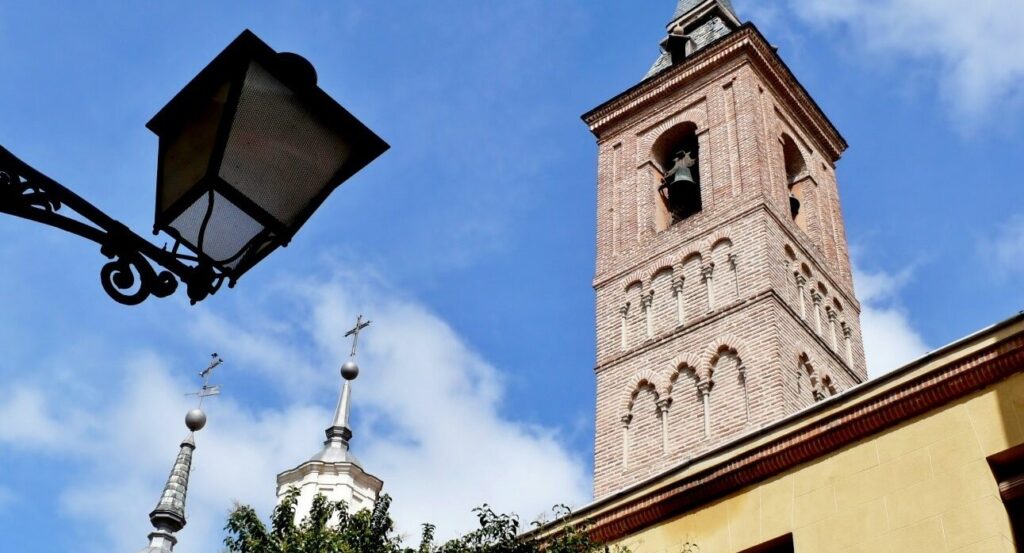Articles, Mayrit hoy
Islamic Madrid: heritage, identity, and the right to the city I
Article author: Daniel Gil-Benumeya Flores
Date of publication of the article: 28/09/2023
Year of publication: 2023
Article theme: 2023, Al-Andalus, heritage, History, Islam, Madrid, Mayrit, Patrimonio.
Introduction
The stigmas and exclusions that weigh on Muslim or perceived Muslim populations in Europe, usually analysed from the perspective of Islamophobia, racism, xenophobia and other sources of otherisation and inferiorisation (Hajjat and Mohammed, 2016: 25), are also related to certain social representations of history, used to explain and legitimise exclusion. Fatima El Tayeb (2021) notes how, in general, non-white populations have tended to be constructed in public discourse as inherently non-European, foreign, newly arrived and excluded both from Europe’s past and from any legitimate claim to belonging in the present. This perception is related to what Stuart Hall (1991) called the “internalist narrative” of European identity, which is the idea that Europe is a historically coherent, homogenous entity whose development is not influenced, at least significantly, by peoples and cultures that are conceptualised as non-European. Muslimness, real or perceived, tends to represent, in Europe, the quintessence of foreignness, and in the specific Spanish case, there is a strong association with the historical stereotype of the Moor (González Alcantud, 2002), the latter understood not so much as a figure absent from the past, but as an essential antagonist, who was expelled and whose return should be avoided. It is therefore very common to mobilise a certain representation of history to justify the exclusionary devices of the present (Aidi, 2006; Zapata-Barrero, 2006).

The Muslim population of the city of Madrid, which numbers around 100,000 people, also experiences this tension between the rampant logic of discrimination and their right to the city (Lefebvre, 2017), that is, to inhabit it and intervene in it with full social, institutional and symbolic recognition. This tension is crossed by the paradox of the formal consideration of Islam in Spain as a religion “of notorious roots” (Planet Contreras, 2008), due to its historical presence, and a widespread social and institutional habitus that tends to consider Muslims as foreigners, even though they have Spanish citizenship (Téllez, 2014; Lems 2020), which naturalises various practices of discrimination and expulsion from public space that are exercised against them. The Muslim presence in Madrid comes mostly from immigration and is later than in other European capitals. Paradoxically, however, and due to its more than seven hundred years of historical Islamic presence (Andalusian, Mudejar and Moorish), Madrid can be said to have been, in the words of Christine Mazzoli-Guintard (2009: 220), “at the crossroads of civilisations” a millennium before post-colonial migrations. The way in which the Islamic is imbricated in Madrid’s history from the very roots of the city and not only in its Andalusian period, but permeating the later medieval and modern periods, challenges political and media discourses that present Islam and Muslims as an intrusion and threat to the culture and ways of life considered its own, insofar as it questions the very dichotomy of the proper and the alien.
To critically renew knowledge of Madrid’s Islamic history and heritage in a way that also benefits the inclusion of today’s Muslims in Madrid.
The Madrid case, therefore, offers an opportunity to investigate the relationship between history, memory, identity and social diversity. It allows us to research the ghosts that the past projects onto the present, understanding the ghost as a social figure that makes visible or manifests, directly or subtly, abusive systems of power and unresolved violence that continue to inform social life, especially when they are taken for granted or when their oppressive nature is denied (Gordon, 2008). It also allows us to ask whether and how it is possible to critically renew knowledge about Madrid’s Islamic history and heritage in a way that also benefits the symbolic inclusion of Muslims in Madrid today, because it contributes to changing the social representations of history that are at play in mechanisms of inclusion and exclusion (Liu and Hilton, 2005). And finally, it allows us to discuss whether all this could be done without producing other forms of essentialism and historical presentism, and whether it is possible, in any case, for efforts of this kind to have real effects, in competition with the major devices of ideological production.
These are the foundations of an experiment based around the Centre for the Study of Islamic Madrid (CEMI), a project under the auspices of the Islamic Culture Foundation (FUNCI). It is an initiative that aims to contribute to the knowledge and protection of Madrid’s Islamic legacy, but also, and above all, to encourage reflection on the construction and representation of Madrid in relation to the challenges posed by the diversity of today’s Madrid society. The aim of this article is to describe the trajectory of this initiative over the course of five years (2017-2022) and to critically assess it. First, it briefly introduces the issue of Madrid’s historic Islamic legacy and the problems it raises in relation to representations of collective identity and heritage management. Next, it shows the development of the aforementioned project, its theoretical bases and some of its main lines of action. Thirdly, the scope and doubts raised by the project’s approach are analysed in conclusion.
Heritage, history and memory of Islamic Madrid

Heritage is a system of symbols that transmit collective identity and memory (Kingman Garcés, 2004; Marcos Arévalo, 2004) and is therefore, like them, the result of social constructions, institutionalised in accordance with political meanings that respond to contemporary hegemony requirements. All societies have a virtual repertoire of potentially heritage elements from history, nature or creative inspiration, but not all of them form an effective part of heritage, but are the object of processes of patrimonialisation (Prats, 2005). There is a material and symbolic economy that defines what matters or does not matter in terms of heritage at any given moment (Kingman Garcés, 2004), and consequently activates some of these elements and minimises or hides others, thus generating different versions of heritage, identity and memory: different versions of the ‘we’ (Prats, 1997; 2005). These socially and politically constructed versions of identity, to the extent that they become hegemonic and naturalised, “legitimise systems, policies, states of affairs and concrete actions” (Prats, 1997: 35). The processes of patrimonialisation, therefore, are linked to the ‘production of types of memory’ (Kingman Garcés, 2004: 32) that have political meanings, and for this reason heritage constitutes a field of symbolic confrontation. Transferring the above to the case of Madrid, we can say that Madrid has a wide repertoire of heritage elements related to its specific Islamic history, as well as to Spain’s historical relationship with the Islamic world and the current Muslim presence, but its heritage activation as a component of the ‘we’ is conflictive.
It is known that Madrid appeared in history in the second half of the ninth century under the name of Maŷrīṭ [1], as part of a series of foundations carried out under the initiative of Amir Muḥammad I. Its first history was written in Arabic (Viguera Molins, 1992) and its first known inhabitants were Muslims (Ávila, 2011). The military character of early Madrid seems to have coexisted with – or evolved into – a civilian population, consistent with the existence of an aljama mosque and a cadi, as well as a large habitat outside the walls with evidence of agricultural and artisanal work (Mazzoli-Guintard, 2009). There are records of various personalities linked to Andalusian Madrid (Ávila, 2011), the most important of whom was the mathematician and astronomer Maslama al-Maŷrīṭī. Madrid belonged to Al-Andalus for just over two centuries, until its conquest by Alfonso VI in 1083 or 1085. It developed from then on as a Castilian city, but had a small Mudejar Muslim community, well known especially in its final stage, which preceded the forced conversion of 1502 (Miguel Rodríguez, 1989).

Much less studied than their Mudejar predecessors, the Moriscos of Madrid (Prieto Bernabé, 1991; Moreno Díaz del Campo, 2017) were confused throughout the sixteenth and seventeenth centuries with other forms of Muslim and crypto-Muslim presence, embodied by the enslaved or deported Moriscos from Granada, the slaves of Maghrebi, Ottoman or sub-Saharan origin (Larquié, 1970), or the Muslim ambassadors, exiles and hostages, a product of the foreign policy of the Habsburgs (Alonso Acero, 2006; Paradela Alonso, 2011). It was at this late stage of Islam in Madrid that the permanent establishment of the Court in Madrid took place (1561). In addition to profoundly modifying the urban physiognomy, the capital developed a concern for the origins of the Villa – as Madrid is antonomastically called – whose history would henceforth be narrated in the light of its condition of urbs regia, the seat and symbolic embodiment of power (Río Barredo, 2000; Mazzoli-Guintard, 2011). The forging of founding myths in accordance with the symbolic needs of the Monarchy, linked both to the Greco-Latin heritage and to primitive Christianity, was accompanied in the sixteenth and seventeenth centuries by the destruction of most of the medieval remains. In the religious sphere, the three great devotions of Madrid also developed, anchoring Madrid in the logic of what would later be called the reconquest: the virgins of Atocha and the Almudena – the latter with the paradoxical Arabic name – and the Mozarabic saint Isidro. The development of scholarly history in the eighteenth and nineteenth centuries, as well as the rediscovery of Arabic sources, put an end to these fables, at least in the educated sphere (Mazzoli-Guintard, 2011). However, it did not substantially change the way of relating to an Andalusian past whose scarce material remains continued to disappear as a result of urban modernisation until the mid-twentieth century. Nor did it put an end to the efforts of a significant part of historiography to find pre-Islamic origins for Madrid, which would provide support for the myths and legends of the Reconquest and would be in line with the symbolic needs of the capital.
From the mid-twentieth century and in the following decades, however, some steps were taken towards the patrimonialisation of Andalusian Madrid, with the rediscovery and preservation of a section of the Emirate wall and the encouragement for research into the Arab-Islamic history of Madrid (Oliver Asín, 1959). Although the attribution of a pre-Islamic origin was maintained, more for convenience than for effective evidence in that sense (Mazzoli-Guintard, 2011: 25). At the end of the century there was a qualitative leap in the development of archaeology in Madrid, which gave rise to a renewed interest in the Andalusian period in both the scientific and institutional spheres (Mazzoli-Guintard, 2011). Some symbolic recognition was also promoted, with the creation of the Emir Mohammed I Park (1986) and the more modest tribute to the astronomer Maslama al-Maŷrīṭi, through the naming of the small square of Maslama (1985). They remain to this day the only two commemorative names in the urban street map dedicated to the Andalusian period of the city (Gil-Benumeya, 2022).

In contrast, with the turn of the century, institutional interest in Islamic Madrid seems to have waned, leading to what we consider to be a devaluation of its heritage. This is despite two important archaeological discoveries: that of the Andalusian and Mudejar cemetery in the city centre (Murillo Fragero, 2009) and that of several dozens of metres of Emirate walls, houses and streets during the construction of the Royal Collections Gallery (Andréu, 2020). During the second decade of the 21st century, perhaps due to the lack of material evidence of a pre-Islamic Madrid, a revisionist artifice has received institutional and media support, consisting of affirming, on the one hand, that Andalusian Madrid only existed as a barracks (Andréu, 2020: 90), so that the foundation of the city as such would already be the merit of the Castilian kings, and, on the other, in amalgamating the origins of Madrid with remains from Roman and pre-Roman times found not on the original site of the city, but in its contemporary municipal district, which is much larger (Gil-Benumeya, 2015: 177-200). This contradictory way of affirming both the pre-Islamic and post-Islamic origins of the city, leaving the Andalusian period in the shadows, has a relative correlation in municipal museums. On the one hand, the Museum of the History of Madrid begins its historical journey in 1561, with the capital city, and excludes the previous seven hundred years at least, about which it provides no more information than the brief explanation that Madrid was “a small medieval town in the kingdom of Castile” [2]. On the other hand, the San Isidro Museum or Museo de los Orígenes dilutes the history of Andalusian Madrid into that of the municipality and the region, with a limited selection of pieces, since it is the Regional Archaeological Museum, located in Alcalá de Henares, which holds the archaeological finds of the Andalusian Maŷrīṭ.
In the case of Madrid, therefore, there are difficulties in patrimonialising, that is, in including both the historical Islamic legacy and the current Muslim presence in the construction of the ‘we’.
This devaluation of the heritage of Islamic Madrid, both in absolute terms and in relation to the processes of patrimonialisation that took place in previous decades (Mazzoli-Guintard, 2009: 218-219) could be related to the symbolic rearmament of Spanish nationalism that began in the second decade of the century (Batalla Cueto, 2021) and to the (mis)reception of the Andalusian in a context of growing Islamophobia. We are not talking about open hostility towards Islamic heritage, but rather about the effects of a banal nationalism (Billig, 2014), a routine, everyday habitus that tends to disregard this part of Madrid’s history in relation to others, within a context of nationalist reconfiguration and demonisation of Islam, and it must also be said, of endemic mistreatment of non-capitalisable historical heritage. The banality is also due to the fact that the history of Madrid is not, for the moment at least, a relevant terrain of symbolic political and media confrontation.
The latter can also be understood as an effect of the veil that hangs over Madrid’s Islamic history, which is not very well known except in specialised spheres – academic or otherwise – so that its historiographical intricacies are not usually shown in the public arena.

In the case of Madrid, therefore, there are difficulties in patrimonialising, that is, in including both the historical Islamic legacy and the current Muslim presence in the construction of the ‘we’. Even in those cases in which Madrid’s Islamic history is evoked, it is usually given the traces of a marginal and circumstantial, if not antagonistic, presence (Gil-Benumeya, 2022). As for the current Muslim presence, its full insertion in the logic of citizenship is not a reality (Salguero and Siguero, 2021). Moreover, Muslim civil society in Madrid has tended to follow the general trend of Islam in Spain, which, unlike in other European states, has not tended to make demands for the revision of the symbols of national identity and equality in political and administrative participation (Salguero and Griera, 2022: 109). The main initiative of symbolic inclusion of Muslims in Madrid has been the festival ‘Nights of Ramadan’: intermittent, because it has not always received institutional support, and paradoxical, because it is an event in which the Muslim associative fabric is practically absent (Gil Flores, 2019: 538).
Reclaiming history. Heritage activation and the right to the city
Against this background, in recent years the research and social intervention initiative that is the main object of this work has been taking shape, the aim of which is the “patrimonial activation” (Prats, 1997) of Islamic history in Madrid, in order to contribute to renegotiating certain social representations of it. It should be remembered that social representations of history have a significant impact on society’s sense of collective identity, on the legitimisation of actions and on its relations with others, including minority groups within the same society. And also in the construction of possible futures, insofar as they provide analogies that guide responses to different situations (Liu and Hilton, 2005), and thus, like heritage, constitute a field of symbolic confrontation.

The main instrument of this experience has been the Center for the Study of Islamic Madrid (CEMI), a project without its own legal entity, developed within the framework of the Islamic Culture Foundation (FUNCI) since 2017, with the intention of associating and developing various interests that some stakeholders had been showing in previous years for the exploration of Islam in Madrid, both historical and contemporary.
The initial intention was to articulate a series of activities that could serve as an educational and reflective tool along three lines. The first of these is the research and dissemination of the long Islamic history of Madrid: Andalusian, Mudejar and Moorish. These are very unequally studied periods that are rarely approached from a comprehensive perspective, among other reasons because their study corresponds to different academic disciplines. Moreover, it is a story that does not tend to transcend specialised circles. The second line is to encourage reflection on the way in which history has been and is (or is not) narrated: how the memory of the past is selected, institutionalised and reproduced, which also includes its patrimonial treatment. These two lines connect with the notions of public history (Glassberg, 1996) and public humanities (Smulyan, 2021) in the sense that it aims to link academic knowledge with the citizen sphere in the collective discussion of the past and the protection of heritage. The aim is to disseminate and make knowledge accessible outside the academy, safeguarding scientific rigour and, in fact, maintaining a critical stance on the proliferation of certain forms of pseudo-historical dissemination. At the same time, the aim is to investigate memory and discuss, in interaction with the public, how historical narratives are created, received and institutionalised in our society, and how they are linked to certain power relations. The third line tries to relate the two previous ones to current Madrid and Spanish society in terms of the management and defence of heritage, on the one hand, and, on the other, the symbolic inclusion of minoritised cultural and religious groups in a context of increasing nationalism (Batalla Cueto, 2021), racist practices and exclusionary identity discourses (García Sanjuán, 2018).
This line of vindication of difference and the right to inclusion focuses on intervention in public space, where social mixing and citizen participation are preferentially verified, which makes it a privileged place to exercise the “right to the city” (Lefebvre, 2017) as well as to develop a “pedagogy of otherness” (Carrión 2007: 83-84), understood as respect for the existence of others in the same space. This is done through the creation of both tangible (spatial) and intangible (imaginary) places of encounter and contact.
All these lines of work and reflection have taken shape in various initiatives, which have been deployed experimentally and with varying degrees of concreteness and continuity. They are summarised below under four headings: urban itineraries, academic synergies, institutional synergies and other activities.
Notes
[1] The Arabic transcriptions use the following system: ˀ -b -t -ṯ-ŷ -ḥ-j -d -ḏ-r -z -s -š -ṣ-ḍ-ṭ-ẓ-ˁ-g -f -q -k -l – m -n -h -w -y. Vowels: a -i -u -ā -ī -ū. The article is transliterated al-. Other features do not apply.[2] Text of the sign at the entrance to the Museum of the History of Madrid (27/7/2022).


